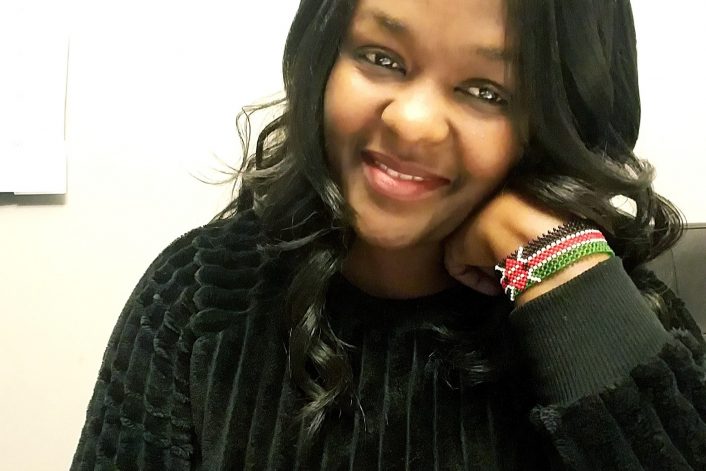JOEY PETERS
IT STARTED a month ago for Lenis Oenga with coughing and wheezing. Oenga, who works as a licensed practical nurse at an assisted living center in Elk River, knew she had been exposed to COVID-19 after tending to two residents earlier in the week who were infected with the disease.
After the coughing and wheezing came a high fever, and then body aches. One morning as Oenga rose, she realized she couldn’t smell the soap she used to wash her hands or taste the toothpaste she used to brush her teeth. Just to make sure she lost her senses of smell and taste, Oenga chewed on garlic. Nothing.
At her worst, about one week into experiencing symptoms and a few days after testing positive for COVID-19, Oenga was coughing so hard and so frequently that she could not talk to her husband, who was caring for her, or her three daughters, with whom she spoke using Facetime to avoid infecting them. One day, she was so weak she passed out three times while trying to use the bathroom.
“The first time I passed out, I got up to go to the bathroom and then I fell on the bedroom floor,” Oenga said.
“My husband came and helped me; put me on the bed.”
After an hour, she sat up on her bed. “Just from a lying position to a sitting position, I passed out again.” She made it to the bathroom the third time, but passed out after she got there.
In the past two months, COVID-19 has ravaged Minnesota’s long-term care facilities, particularly in the Twin Cities, accounting for some 80 percent of statewide deaths related to the virus, according to state numbers.
While much public attention has been focused on residents — many of them elderly and with existing conditions that put them at high risk — less has been paid to the workers who spend their days attending them. Like Oenga, who is originally from Kenya, many of these workers on the frontlines of long-term care centers in the Twin Cities are African immigrants.
It’s a point that Lyna Nyamwaya, a nurse until recently, said she has stressed in recent talks with public officials. Nyamwaya is president of the African Nurses Network, which she founded in 2016 to raise the visibility of the state’s African immigrants health care workers. The group includes about 200 local African immigrant healthcare workers among its membership.
“My concern is, yes, we care about the residents,” Nyamwaya, who is originally from Kenya, said. “But who’s speaking for the caregivers?”
They’re getting sick, too. Earlier this month, Minnesota Health Commissioner Jan Malcolm cited statistics indicating that while black congregate health care workers make 19 percent of the industry’s workforce in Minnesota, they account for 43 percent of that workforce infected with the virus—the highest of any racial group. By contrast, white congregate care workers made up 74 percent of the workforce, but just 38 percent of workers infected with the virus.
Many of these black workers, Malcolm said, are African immigrants.
Nyamwaya said the state’s numbers reflect the reality on the ground. They include workers in recent COVID-19 hotspots like St. Therese of New Hope, where more than 50 residents have died, and North Ridge Health and Rehab, where more than 40 residents have died.
Nyamwaya said she knows at least 10 African immigrant nursing assistants who’ve gotten sick with COVID-19; Oenga said she knows at least 15 African immigrant friends who’ve been infected, including a resident at a long-term care center who died. Like the rest of the population, Nyamwaya and Oenga have heard of their friends’ symptoms ranging from nothing to severe.
“They’re affected, they’re infected, they’re infecting their families,” Nyamwaya said of the healthcare workers. “Some have been hospitalized, some are recovering, some are sick as I speak with you.”
Before contracting the virus, Oenga, 38, said she had no preexisting health conditions that would make her more vulnerable to a severe infection. Now one month after first experiencing symptoms, Oenga is still bedridden but hopeful that the worst is behind her.
On the Friday before Memorial Day, she felt good enough to go outside of the house briefly with her kids. “We kept our distance,” she said. “I had a mask on.”
African immigrant care workers who spoke with Sahan Journal cite various reasons why so many are getting sick. Many African immigrants work on the frontlines, directly caring for patients and residents, which increases the danger they’ll be exposed. Many also work more than one job and transfer shifts from one care facility to the next, sometimes during the same day. Some have obligations to support extended families in their home countries and don’t have paid sick days.
Edwin Bogonko, a doctor of internal medicine at St. Francis Regional Medical Center in Shakopee, said healthcare jobs like nursing assistants, residential nurses and LPNs appeal to African immigrants because they often already have experience working in healthcare, and there’s an existing community of immigrants working in the field here.
Nursing assistant positions are the most entry-level, averaging $32,000 a year in the state, according to the federal Bureau of Labor Statistics. LPN salaries average $45,000 while RNs average $78,000.
“People tend to gravitate to careers where they feel accepted and accommodated,” said Bogonko, who also is originally from Kenya.
They’re also often breadwinners, for not just their immediate family, but also extended family. Oenga, for example, said she’s supporting her father, who lives in Kenya and is pushing 90. Bogonko said situations like these are common.
“There is a lot of financial pressure as a person who has managed to get out of the environment of very little,” Bogonko said. “What this translates to is a tendency for a lot of immigrants to work nonstop.”
This situation can push African immigrants to work multiple jobs in multiple long-term care centers. In the age of COVID-19, this translates to a higher risk of being infected with and spreading the virus “not because of a fault of [their] own, but because of survival,” Bogonko said.
“What ends up happening is, a lot of them are trying to make ends meet, they work in multiple places, in the process they not only multiply the risks to themselves, but they also multiply the risk of passing COVID-19 specifically from one setting to another,” he said.
It’s also common for both wage-earners in a family to work in healthcare. Oenga’s husband is a nurse at a local hospital and cares directly for COVID-19 patients.
Oenga said her husband took two and a half weeks off of work to care for her when the virus was at its worst. He periodically brought in food for her and checked on her, all the while wearing an N95 mask and doing his best to protect himself. Oenga got paid sick leave for two-and-a-half weeks; she said her husband did not receive paid leave for his time helping her.
So far, Oenga’s husband and three daughters, aged 7, 9 and 13, have been able to avoid getting sick, for which she’s thankful.
She recently celebrated the birthdays of her two oldest daughters over Facetime while being quarantined in her bedroom. “I can hear them in the house but I cannot see them,” she said. ‘It’s a hard one, but it could be worse.”
Other long-term care workers who spoke to Sahan Journal pointed to an initial lack of testing and personal protective equipment at nursing homes during the first month of the pandemic. In early May, Gov. Tim Walz announced a “five-point battle plan” to curb the virus at long-term care centers, including significantly increased testing of residents and care workers for the virus and increased personal protective equipment.
James, an African immigrant who works as a nursing supervisor at a Brooklyn Park facility, said his workplace employs many nurses on an on-call basis. These on-call nurses have a greater chance of infection, James said, because they can’t afford to take days off. He did not want his last name or the name of his workplace published for fear of retribution.
At James’ workplace, he said 30 percent of residents have been infected with the virus, but two-thirds of them have recovered.
“That’s very promising,” he said of the recovery rate. “The worry is, what’s next?”
Nurses and workers at his facility are soon going to test for the virus as a part of the state’s five-point plan, he said. He’s worried that nurses may be afraid to get tested because they worry that testing positive will cause them to miss a paycheck.
“Many nursing home workers are asymptomatic carriers,” James said. “I’ve never had symptoms. I could be spreading it around and have no clue.”
James said he sympathizes with employers who may worry that mass testing of their employees will leave their facilities understaffed.
“You could understand why it’s going to be a disaster if all the nursing home employees are at home,” he said. “People could die from lack of care, not just coronavirus. It’s unfortunate, but that’s the reality.”
Jamie Gulley, president of Services Employees International Union Healthcare Minnesota, which represents workers at nursing homes across the state, said his union did not yet have hard evidence as to why the virus was infecting black care workers so disproportionately.
Gulley said the virus has so far affected fewer nursing homes outstate than in the Twin Cities metro area, where the workforce is more diverse. He also stressed that just 30 percent of nursing homes workforces in the state are unionized and argued they have less bargaining power to demand workplace safety.
In a month or two, the virus may make its way across the state, Gulley said, and infection numbers might “even out” in rural areas. The current numbers might just be a “snapshot in time,” he said.
However it plays out, Oenga is worried that African immigrants feeling the brunt of the disease will remain invisible through the crisis.
“Yes. I go to work, I get a check to pay my bills, but at the same time my heart is at peace knowing that I took care of these people,” she said. “But when we get sick … it feels like, apart from my husband and my kids, I’m fighting this all by myself.”
“We have our families, we have people we take care of, we take care of each other in the community, we put our lives at risk,” she said. “But to be honest with you, it’s like our efforts are not appreciated. I don’t think there’s anyone that is seeing us.”
(Source: SAHAN JOURNAL)







